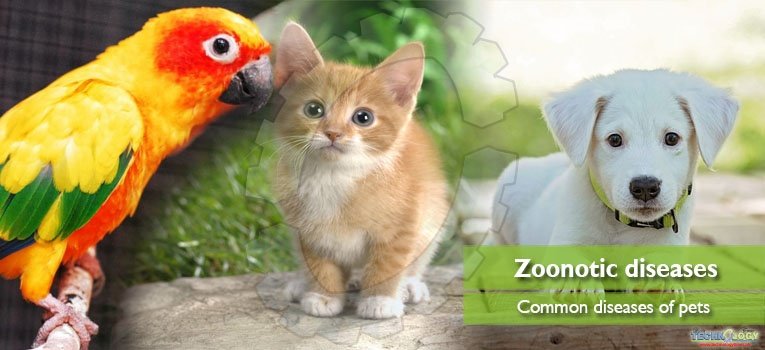The diseases which are transferred from animals to humans are termed as zoonotic, which are rare but severe. Here are some zoonotic infections that can easily be transferred from pets to humans and are significant importance.

It is hard to get away from pets, whether people love or hate them. Even if you have no pet, you like to come across them. Most interactions between pets and humans are likely to be positive but they can also spread some diseases that infect humans. The diseases which are transferred from animals to humans are termed as zoonotic, which are rare but severe.
Common zoonotic diseases
Rabies
It is a fatal zoonotic viral disease that can be transmitted by biting saliva of infected animal. This virus is commonly present in unvaccinated dogs and other canine populations. About 55000 deaths are reported worldwide per year due to rabies out of which 56% occur in Asia. In areas where rabies is endemic, people usually become infected when they are bitten by an affected dog. This virus attacks the brain, and if there is development of signs and symptoms then there is no treatment of this disease. It can be prevented by vaccination and reducing the population of stray dogs. If bitten by a dog, following management steps need to be taken:
- Immediately wash the wound with soap, ethanol or aqueous iodine
- Administration of rabies immunoglobulin
- Post exposure prophylaxis need to be applied as soon as possible at 0, 3, 7, 14 and 28 days intramuscularly.
Salmonella
Salmonella primarily causes enteritis and septicemia, however, many species carry bacteria that can be shed in their feces. Ingestion of contaminated animals or animal products like eggs, meat etc. and direct contact with infected animals are the major route of transmission of disease in humans. Dogs and cats can also carry infection, sometime causing diarrhea. But it is commonly present in pet reptiles and amphibians. Following measures need to be taken for salmonella infection:
- A combination of ampicillin and enrofloxacin antibiotic is recommended.
- Always wash your hands after handling both pets and raw pet food.
- Contaminated utensils must be cleaned and disinfected.
- Vaccination can reduce colonization and shedding of salmonella in the environment.
Toxoplasma
It is a parasitic disease and these parasites can also be found in the feces of infected animals. This parasite is especially present in warm and humid environment but significant number of cases have also been reported from the cold region. Infection can be transmitted by eating raw or uncooked infected food. Milk born and venereal transmission is also possible. It shows severe signs in immunocompromised and pregnant women. If women become infected, severe congenital defects develop in fetus and the fetus may abort.
Pregnant women have to take more precautions like avoiding cleaning of cat litter trays, and eating undercooked food where cats may have access. Clinical cases are treated by using combination of antibiotics such as clindamycin, trimethoprim-sulfonamide, azithromycin and pyrimethamine.
Ringworm
It is fungus-borne skin infection that can infect animals and is mild in humans. Infection is also called as dermatophytosis. Many species of animals can get ringworm infection which include dog, cat, sheep, goat and cattle. Ringworm infection can be caused by close contact with pets or by infected spores in the environment. Affected cats, dogs and other animals can show few signs. However, in its classical form, pets with ringworm infection have ring type rashes on skin, cause hair loss and the skin becomes red and itchy. Infection is closely related to the cause of athlete’s foot in people. In case of ringworm infection, following measures should be adopted.
- Best way to protect yourself from infection is to take hygienic measures.
- Wash your hands after contact with animals.
- Clean and disinfect the area where animals reside.
Bites and scratches
Bites and scratches are also among the most common cause of zoonosis. Cat bite and scratches may transmit a bacterium called Bartonella henselae that causes cat scratch disease. Both bite and scratch wounds are infected and causes pain. Infection is most often benign and self-limiting in immunocompetent animals. While in immunocompromised animal, it can be fatal without antibiotic treatment. Cats and dogs are reservoir host of B. henselae. Following measures should be taken in case of bites and scratches.
- Any bite and scratch should immediately be washed with soap.
- Declawing doesn’t seem to affect transmission but cutting of nails is suggested.
- Flea control will minimize the cat to acquire henselae or to transmit to other cats.
Zoonotic infections are not so common but these are very dangerous. Most of the infections can be transferred to other humans and the risk of zoonotic disease will always be there. It can be minimized by awareness about above discussed diseases and by vaccinating and properly treating the diseased animals. Taking hygienic measures is also very much important for controlling disease transmission. In case of any doubt about the risk of any disease, veterinarian and physicians must be consulted.
This article is jointly written by Muhammad Hunain Ahmed, Muhammad Kashif Javaid, and Muhammad Haider Ali.